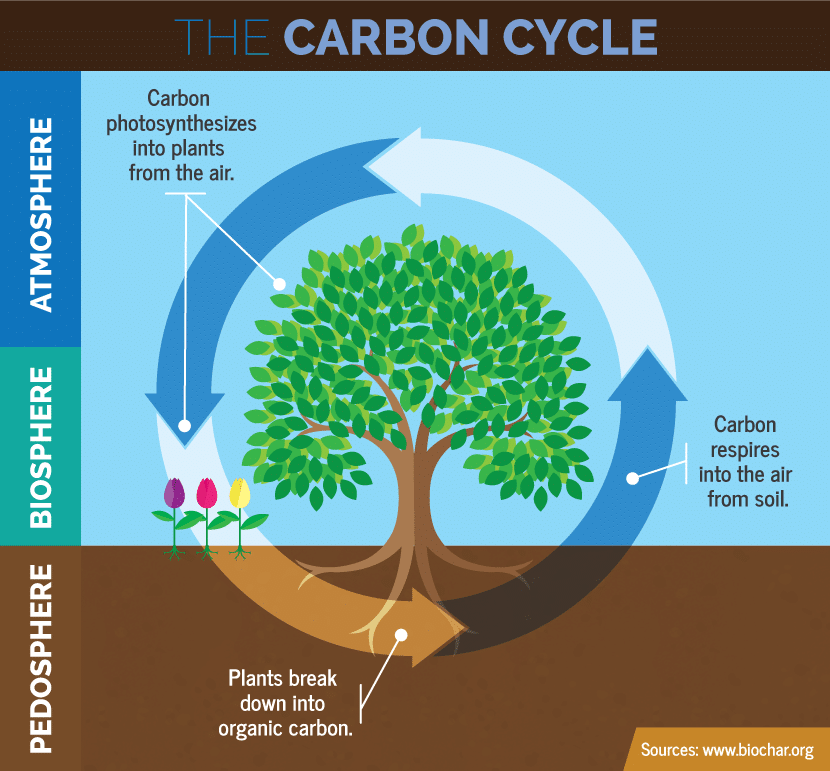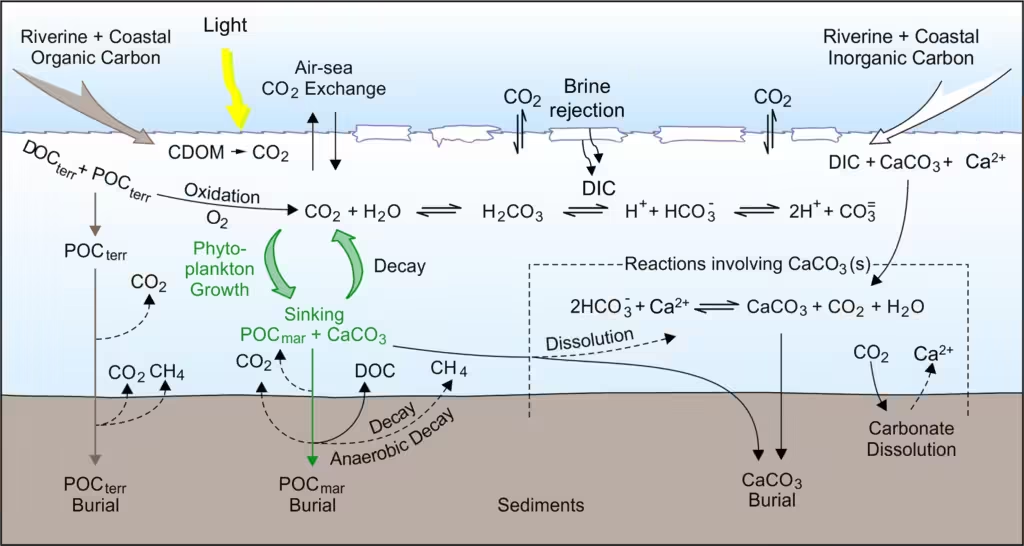Introduction
Every year, human activities release over 30 billion metric tons of carbon dioxide into the air. This pollution is causing a climate crisis that harms ecosystems, communities, and economies around the world. The increase in carbon emissions is warming our planet faster than ever, making it crucial to find effective solutions to climate change.
In the fight against climate change, nature offers a strong defense: natural carbon sinks. Forests, grasslands, and healthy soils are important because they capture and store carbon from the atmosphere. Trees absorb carbon dioxide during photosynthesis and keep it in their trunks, branches, and roots. Meanwhile, healthy soils hold carbon underground for hundreds of years.
How Trees Capture Carbon:
Trees and plants are great at capturing carbon through a process called photosynthesis. In photosynthesis, leaves take in carbon dioxide (CO₂) from the air through tiny openings called stomata. Sunlight provides the energy that helps trees turn this CO₂, along with water from their roots, into glucose, a type of sugar that helps the plant grow. As trees grow, they use this glucose to create biomass, building their trunks, branches, leaves, and roots, all of which contain carbon.
This carbon stays stored in the tree as long as it is alive, helping to reduce the amount of carbon in the atmosphere. However, when trees die, the carbon can go back into the air as they decompose. If trees are left alone in healthy forests, they can store carbon for many decades or even centuries, making them powerful long-term carbon sinks.

Page URL: https://commons.wikimedia.org/wiki/
Attribution: Bvelevski, CC BY-SA 4.0 https://creativecommons.org/licenses/by-sa/4.0, via Wikimedia Commons
How Soil Stores Carbon:
Soil captures carbon through organic matter, which includes decaying plants, animal remains, and substances released by roots. When plants and animals break down, they release carbon compounds. Microorganisms like bacteria and fungi then transform these compounds into stable forms of carbon that can stay in the soil for hundreds or even thousands of years. This process creates a stable “carbon bank” in the soil.
Roots also help store carbon in the soil by releasing exudates, which are carbon-rich substances that feed soil microbes. These microorganisms break down organic matter and help create complex carbon compounds that bond with soil minerals, making it harder for carbon to escape back into the atmosphere. This activity, along with strong root systems, boosts the soil’s ability to store carbon, creating a natural reservoir that supports both plant growth and carbon capture over time.
Quantifying Carbon Storage:
Forests and soils are some of the biggest natural carbon sinks on Earth, absorbing large amounts of carbon dioxide each year. It’s estimated that forests around the world sequester about 7.6 billion metric tons of CO₂ annually, with tropical rainforests contributing nearly 50% of this capture. In addition, soils hold about three times more carbon than what’s in the atmosphere, capturing around 2 to 3 billion metric tons of CO₂ each year.
Different ecosystems have different abilities to store carbon.
Rainforests: These are very effective carbon sinks, storing about 250 metric tons of carbon per hectare above ground and another 50 to 100 metric tons in the soil.
Grasslands: These areas store most of their carbon in the soil because frequent fires and grazing limit the growth of aboveground plants. Although they store less carbon per hectare than forests, their wide coverage around the world makes them important for carbon storage.
Wetlands: These have the highest carbon storage per area. Peatlands alone hold almost twice as much carbon as all the world’s forests combined because their rich organic soils don’t decompose easily.
Key Benefits Beyond Carbon:
Besides capturing carbon, trees and soils provide many other ecological benefits that are vital in the fight against climate change.
Enhanced Biodiversity: Forests, wetlands, and grasslands support most of the world’s species. By protecting these ecosystems, we help preserve diverse plants and animals, creating resilient ecosystems that can better withstand climate change.
Soil Health: Trees and plant roots help prevent soil erosion by stabilizing the soil and reducing runoff. Decomposing plant matter adds organic material to the soil, improving its fertility and structure.
Water Retention and Regulation: Forests and healthy soils improve water retention, aiding groundwater recharge and stabilizing water cycles. This can help prevent floods and lessen the effects of drought by allowing ecosystems to hold and slowly release water.
Climate-Related Resilience: Protecting forests and healthy soils helps reduce climate impacts like desertification, which degrades land in dry areas. Forested areas can create cooling effects and influence rainfall patterns, helping to control temperatures and precipitation at local and regional levels.
By capturing carbon and providing these additional environmental benefits, forests, grasslands, and wetlands are crucial for a resilient and healthy planet. Preserving these natural ecosystems not only aids in carbon sequestration but also protects vital ecological services that support biodiversity and human well-being.

Page URL: https://commons.wikimedia.org/wiki/
Attribution: David W. Capelle, Zou Zou A. Kuzyk, Tim Papakyriakou, Céline Guégue, Lisa A. Millera and Robie W. Macdonald, CC BY-SA 4.0 https://creativecommons.org/licenses/by-sa/4.0, via Wikimedia Commons
Vulnerability to Climate Change:
As climate change speeds up, natural carbon sinks like trees and soil face increased risks from extreme weather. Events like droughts, wildfires, and storms can weaken trees and soil health, making it harder for them to store carbon. For example, wildfires pose a significant threat to forests, releasing about 1.5 billion metric tons of carbon each year—almost 20% of global fossil fuel emissions. Droughts can also harm forests by slowing their growth and photosynthesis, which reduces their ability to capture carbon.
Changes in land use, such as deforestation and soil degradation, are also major challenges. Deforestation is responsible for about 10-15% of global carbon emissions each year. When forests are cut down or damaged, the carbon stored in them is released as CO₂, and the land loses its ability to capture carbon in the future. Soil degradation, often caused by unsustainable farming practices, can lower organic carbon levels, reducing the soil’s capacity to store carbon.
Capacity Limits:
While trees, soils, and other natural systems capture a lot of carbon, they can’t absorb all the carbon emissions produced by humans. Research shows that the world’s forests can only offset about 10-20% of global fossil fuel emissions each year. For instance, while forests absorb around 7.6 billion metric tons of CO₂ annually, human activities release over 36 billion metric tons. Even under the best conditions, these ecosystems cannot capture carbon quickly enough to keep up with current emission levels. Therefore, we need to combine the benefits of natural carbon sinks with significant reductions in emissions and possibly engineered carbon capture solutions to meet climate targets.
Longevity of Stored Carbon:
The carbon stored in trees and soil is not permanently locked away. When trees die—whether naturally or due to deforestation—decomposition releases the stored carbon back into the atmosphere as CO₂. Soil carbon can also be released if land use or climate conditions change. For example, tilling soil for farming disrupts stable carbon compounds, exposing them to air and speeding up decomposition, which releases carbon.
Fires, land conversion, and temperature changes can all cause carbon to be released, making the storage of carbon in natural systems unpredictable. Projections indicate that, without protective measures, significant amounts of stored carbon could be released by 2050 due to forest degradation, desertification, and other climate change impacts. While trees and soil are vital allies in combating climate change, their ability to store carbon securely relies on stable, healthy ecosystems, which are increasingly threatened by climate change and human activities.
Enhancing Nature’s Carbon Capture Potential
Afforestation and Reforestation:
Afforestation (planting trees on land that hasn’t had trees before) and reforestation (replanting areas that were once forested) are two main ways to increase global carbon capture. By planting more trees, these methods enhance carbon sequestration through photosynthesis, where trees absorb CO₂ and store it as biomass. For example, if done properly worldwide, reforestation could capture 200 billion metric tons of CO₂ over the next century.
However, these methods have some challenges. A major issue is land availability, as large-scale tree planting can compete with agricultural needs or disrupt local ecosystems. Moreover, afforestation and reforestation require a lot of water, soil nutrients, and management to ensure the trees survive and grow. Choosing the wrong tree species or planting in unsuitable climates can also lead to imbalances in the ecosystem and reduce the effectiveness of carbon storage.
Soil Management Techniques:
Sustainable soil management, especially in farming, is a great way to boost soil carbon storage. Techniques like regenerative agriculture, no-till farming, and cover cropping help build organic matter in the soil, allowing more carbon to be stored underground. For instance:
Regenerative agriculture practices, such as crop rotation and integrating livestock, improve soil health and encourage beneficial microbes, which help retain more carbon in the soil.
No-till farming reduces soil disturbance, lowering the chances of carbon being released and keeping stable carbon compounds intact.
Cover crops prevent soil erosion, add organic matter, and help retain moisture, all of which enhance soil carbon storage.
These methods also benefit farmers by improving soil fertility, increasing crop resilience, and reducing the need for chemical fertilizers, supporting sustainable food production.
Ecosystem Restoration:
Restoring degraded ecosystems—like wetlands, grasslands, and mangroves—provides a powerful way to increase natural carbon storage. Wetlands are especially effective carbon sinks, storing carbon in their rich organic soils for thousands of years. Restoring these areas boosts carbon capture, stabilizes water cycles, prevents floods, and creates habitats rich in biodiversity.
Grasslands play an important role in carbon storage, mainly through their deep roots that hold carbon, even if the plants above ground die. Restoring grasslands supports biodiversity, improves soil health, and provides additional benefits like controlling erosion. Mangrove restoration is also effective in coastal areas, as mangroves capture carbon up to four times faster than terrestrial forests and protect coastlines from storms and erosion.
Community and Policy Efforts:
To achieve large-scale carbon capture through natural methods, coordinated action from communities, governments, and international organizations is necessary. Global initiatives, such as the UN’s Bonn Challenge and the Trillion Trees campaign, aim to restore millions of hectares of forests worldwide, highlighting the need for cooperation among nations. Policies that promote sustainable agriculture, protect natural ecosystems, and provide funding for restoration efforts are crucial for scaling these solutions.
At the community level, engagement is vital. Local communities often manage these ecosystems, and their involvement in restoration and conservation ensures that efforts are effective and sustainable. Education programs, economic incentives, and support for indigenous land rights are essential for empowering communities to contribute to carbon capture.
By combining afforestation, soil management, ecosystem restoration, and supportive policies, we can enhance nature’s ability to capture carbon, addressing climate change while benefiting both ecosystems and communities.
Conclusion
Trees and soil are essential for capturing carbon, acting as natural carbon sinks that absorb CO₂ from the atmosphere through processes like photosynthesis and the breakdown of organic matter. Forests store large amounts of carbon in their biomass, while healthy soils hold significant carbon in stable forms, helping to maintain a balanced carbon cycle. These natural methods provide a strong support to technological solutions in our fight against climate change.
Although trees and soil are important allies in combating climate change, they cannot do it all on their own. To effectively address this global crisis, we need to combine these natural solutions with strong efforts to reduce emissions and broader climate strategies. Sustainable practices in agriculture, forestry, and land use are crucial for maximizing the benefits of these natural carbon sinks.
Share the knowledge with

